INDONESIA
Plants and Animals

Plants and Animals

Cities in INDONESIA
| Jakarta | Yogyakarta |
Popular destinations INDONESIA
| Bali | Java | Sumatra |
Plants and Animals
Plants
The Indonesian archipelago has a very rich flora, which changes from west to east in conjunction with the drier climate in this direction. In total there are more than 45,000 flowering plant species, which is about 10% of all kinds of flowers and plants that occur on earth. There are 250 types of bamboo and 150 different types of palms. Some 3,000 tree species are known from the island of Borneo alone, and the rainforests of Irian Jaya are home to more than 2,500 orchid species, including the largest in the world, the tiger orchid with its three-meter trail of flowers. Irian Jaya is also known for its insectivorous pitcher plants.
Sumatra, Borneo and New Guinea are outside the mountain ranges and originally also West and Central Java, respectively, were covered with very dense tropical rainforest. One of the many forest giants here is still the ironwood tree, which stands out for its smooth trunk that can reach a diameter of 2-3 meters and grow up to 40 meters in height. The "waringin" is considered a sacred tree in various parts of Indonesia. The waringin is a fig tree with a tangle of aerial roots that can reach an impressive size.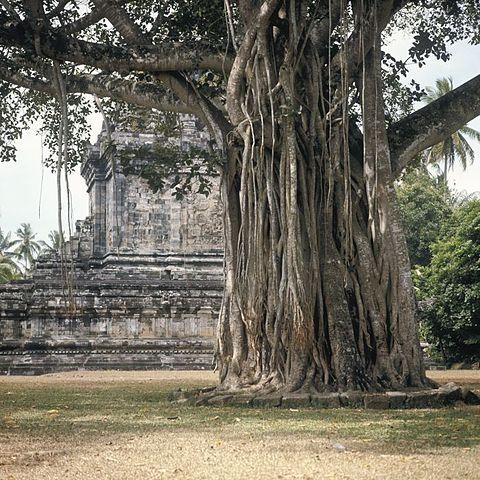 Waringin or ironwood tree on JavaPhoto:Tropenmuseum CC 3.0 Unported no changes made
Waringin or ironwood tree on JavaPhoto:Tropenmuseum CC 3.0 Unported no changes made
Much tropical rainforest is disappearing because the expanding population needs more and more agricultural land and therefore more and more forest is cleared. Felling for the timber industry also has a heavy toll on the stock. A good example is Java, where the forest has been replaced almost entirely by agricultural crops and weeds. In Bali and a large part of Sumatra, the tropical forest has been almost completely replaced by cultivated land (rice fields, rubber and palm plantations).
In drier East Indonesia, the partly bare monsoon forest prevails in the dry season; the wood supplying djatibos is important here. Savannah vegetation occurs on the dry eastern Nusa Tenggara. Depending on how dry the climate is, the forests here are partially or completely deciduous, for example the teak tree.
Along the silty seashores one finds mangrove flood forests, which also extend far inland along the rivers; behind it, especially on Sumatra and Borneo, extensive peat swamp forests often grow in nutrient-poor fresh water. The mangrove trees are characterized by their stilt and breath roots. Rhizophora grows along the coast, recognizable by its dagger-shaped fruits, which have already sprouted before they fall from the tree.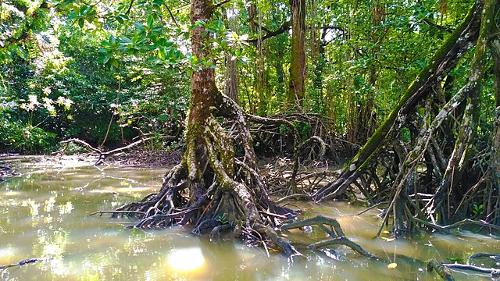 Rhizophora stylosa in the mangrove forest of Cilintang, Taman Nasional Ujung Kulon, Bante on JavaPhoto: Putra Mahanaim Tampubolon CC 4.0 International no changes made
Rhizophora stylosa in the mangrove forest of Cilintang, Taman Nasional Ujung Kulon, Bante on JavaPhoto: Putra Mahanaim Tampubolon CC 4.0 International no changes made
The vegetation of the mountains changes with height and shows belts comparable to the climate belts found between the equator and the poles: up to 1000 meters the tropical belt; up to 1500 meters the sub-mounted belt; up to 2400 meters the montane zone; up to 4000 meters the subalpine belt; above 4000 meters of grasslands with mosses and lichens and scattered shrubs, similar to the alpine flora. In the Gunung Gede Pangrango National Park we find the last remnants of the Javanese mountain flora above the tree line. The Javanese edelweiss, gentians, blackberries, strawberries and St. John's wort grows here. In the cooler mountain regions many ferns, rhododendrons, turpentines, beech, oak and acacia also grow. Orchids live in the jungle as well as high in the mountains.
Typical trees of the archipelago include the palms: coconut palm, oil palm, nipa palm, lontar palm, pandan palm, sago palm, aren palm (palm wine, sugar), betel palm (betel nut), rattan and the many species of the genus Ficus.
In the western part of the archipelago the hardwood supplying Dipterocarpaceae predominate.
Endangered species of Indonesian flora include the famous Rafflesia arnoldii (Central and South Sumatra), the largest parasitic flower in the world, whose blossom can reach a diameter of one meter. The Rafflesia clings to the roots of its host, the lianas Viatceae, from which it also extracts all nutrients. The bud takes two years to hatch. Rafflesia arnoldii is one of the three national flowers of Indonesia, next to the Arabian jasmine (Jasminum sambac) and the moon orchid (Phalaenopsis amabilis).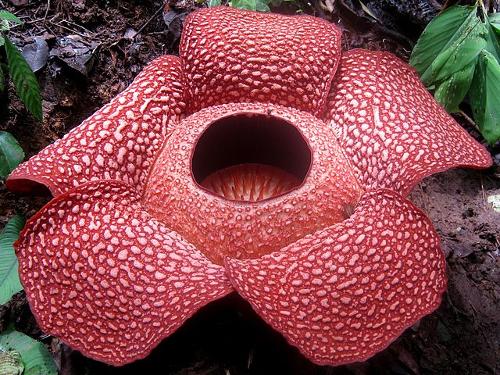 Rafflesia Arnoldii, the largest flower on earth and one of the national flowers of IndonesiaPhoto:Rendra Regen Rais CC 3.0 Unported no changes made
Rafflesia Arnoldii, the largest flower on earth and one of the national flowers of IndonesiaPhoto:Rendra Regen Rais CC 3.0 Unported no changes made
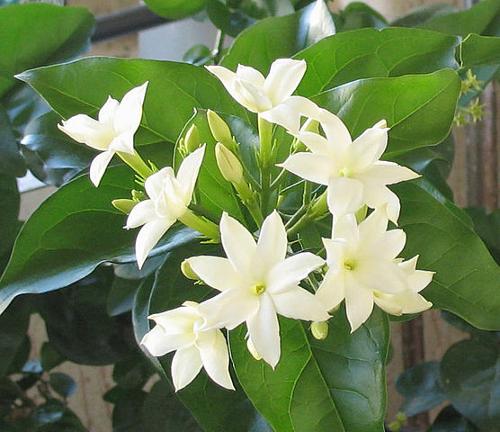 Arabian jasmine, one of the national flowers of IndonesiaPhoto: Kobako CC 2.5 Generic no changes made
Arabian jasmine, one of the national flowers of IndonesiaPhoto: Kobako CC 2.5 Generic no changes made
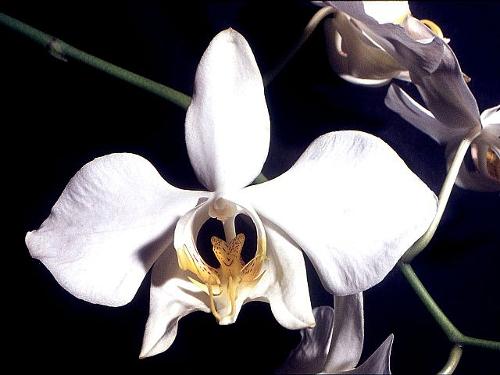 Moon orchid, one of the national flowers of IndonesiaPhoto: Orchi CC 3.0 Unported no changes made
Moon orchid, one of the national flowers of IndonesiaPhoto: Orchi CC 3.0 Unported no changes made
On Borneo we find the only black orchid in the world, the Coelogyne pandurata. A common plant is the "melati", a fragrant jasmine variety. The "angrek bulan" or moon orchid, like the melati and the Rafflesia, has been chosen as the national flower.
One of the most beautiful, lush flowering trees in Indonesia is the flamboyant or forest flame, a tree native to Madagascar. The flamboyant is planted throughout Indonesia as a shade tree.
Indonesia is also known for its wide variety of tropical fruits, including blimbing, manggis, durian, nangka, rambutan, jambu air and salak.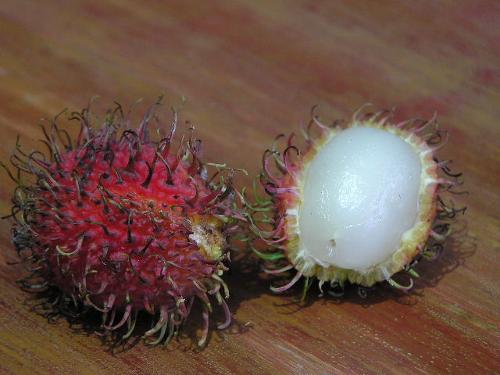 Ramutan, IndonesiaPhoto: Frank wouters from antwerpen, belgium CC 2.0 Generic no changes made
Ramutan, IndonesiaPhoto: Frank wouters from antwerpen, belgium CC 2.0 Generic no changes made
Animals
The animal world of Indonesia shows both Asian and Australian elements. The "Wallace Line" (see below), between the Philippines, Borneo and Bali on the one hand, and Sulawesi and Lombok on the other, roughly indicates the division. Many islands show a mixed fauna and are therefore of great importance to biologists. This transition area is also known as "wallacea".
The fauna of the Grand Sunda Islands, with the exception of Sulawesi, is mainly similar to that of the Asian mainland. Nusa Tenggara, east of Bali, Moluccas (including the Seram pouch) and Irian Barat have a more Australian character, although Asian elements are not lacking. On many islands that were associated with each other or with the continent in the past (Pleistocene), as a result of long-term isolation, new endemic races and species could arise that do not occur anywhere else in the world.
Indonesia's most famous ape is the orangutan ("forest person"), which is only found in Sumatra and Kalimantan (Borneo). The orangutan is a highly endangered species, of which only about 5,000 are left in the wild.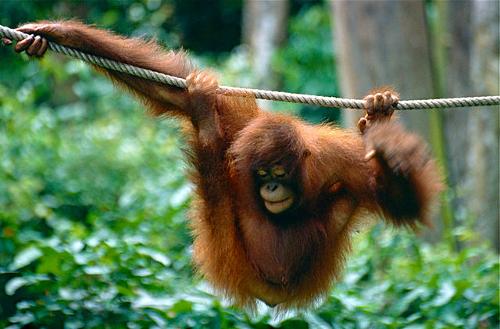 Orangutan, anthropoid ape is only found in IndonesiaPhoto: Bernard DUPONT CC 2.0 Generic no changes made
Orangutan, anthropoid ape is only found in IndonesiaPhoto: Bernard DUPONT CC 2.0 Generic no changes made
The very special looking proboscis monkey is only found on Kalimantan. The male's red nose can grow up to 6 inches long. Gibbons (including siamang, white-handed gibbon, silver gibbon, oenka and Müller's gibbon) are limited to the western islands; Sulawesi and the other eastern islands have different monkey species. The so-called leaf monkeys (langurs or slender monkeys) also occur on Sumatra. There are 30 species and subspecies of these graceful monkeys on Sumatra. The special thing about these monkeys is that they eat a relatively large amount of leaves and seeds. Half-monkeys such as loris and tarsiers, as well as treeshrews, are only found in the west.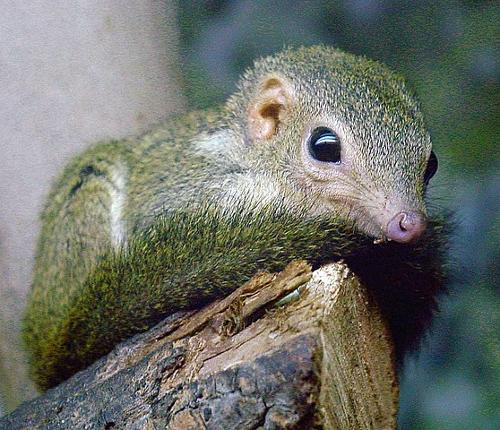 Pygmee treeshrew, IndonesiaPhoto: Paul J. Morris CC 2.0 Generic no changes made
Pygmee treeshrew, IndonesiaPhoto: Paul J. Morris CC 2.0 Generic no changes made
The large mammals of the rainforest are only occasionally seen. Elephants are still found in Sumatra and North Kalimantan. The one-horned Javan rhino is only found in the Ujung Kulon reserve in West Java; the two-horned Sumatran rhinoceros in Indonesia only lives in Kalimantan. The Sumatran tiger is only found in the rainforests of Sumatra, the largest feline of Kalimantan is the clouded leopard. The honey bear or Malay bear is found in Sumatra and Kalimantan. Tapirs live in low-lying swamp forests.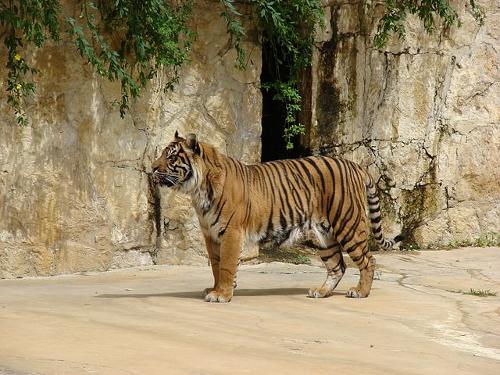 Sumatran tiger, IndonesiaPhoto: Public domain
Sumatran tiger, IndonesiaPhoto: Public domain
Among the ruminants, the banteng or wild buffalo (only in Java), the anoa of Sulawesi and the forest gems of Sumatra deserve mention. The banteng (up to 800 kilos) is closely related to the gaur, the largest wild bovine species. Water buffaloes are domesticated animals. Two species are found in Indonesia: the river buffalo and the swamp buffalo. Both are referred to by the population as carabao or "kebo". The white zebu, called "lembu" or "sapi putih" in Indonesia, probably descends from the wild gaur, but has been domesticated for a long time.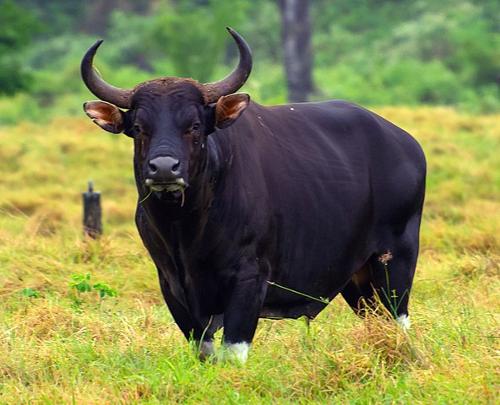 The banteng or tembadau, is a species of cattle found in IndonesiaPhoto: Buyung Sukananda CC 4.0 International no changes made
The banteng or tembadau, is a species of cattle found in IndonesiaPhoto: Buyung Sukananda CC 4.0 International no changes made
Java is home to the Kantjil or Javanese dwarf deer, the Javan deer or "rusa", the rare Javan warthog, the leopard, the black panther and the spotted panther. The Bawean deer is one of the rarest deer species in the world and is only found on the volcanic island of Bawean, 150 km north of Java. The forests of Bromo-Tengger-Semeru National Park are home to wild boars, forest chickens, langurs, "kijang - a small deer- Javan anteaters," and "luwak", a type of marten.
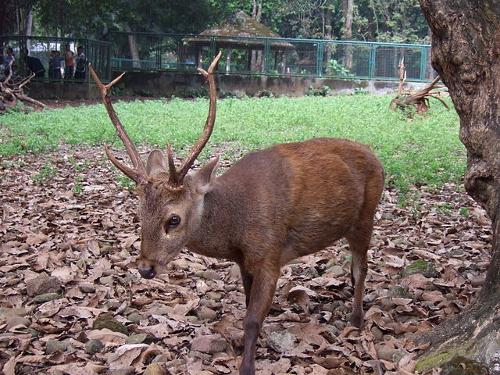 Bawean deerPhoto: Midori GFDL cc-by-sa-2.1-jp no changes made
Bawean deerPhoto: Midori GFDL cc-by-sa-2.1-jp no changes made
The mammal fauna of Maluku (Moluccas) consists mainly of small species of higher mammals and marsupials, such as the flying marsupial squirrel, three kinds of cousins, wallabies or tree kangaroos, and 40 species of bats including small insectivores and the large flying dogs or "kalongs". The sea around the island of Aru is known for the "dugongs" or manatees. The "STD-STI" or water monitor occurs on Ambon. The red lorikeet, the blood spot lorikeet, the red crested cockatoo and the blue-rumped honey parrot are in great demand for the live bird trade.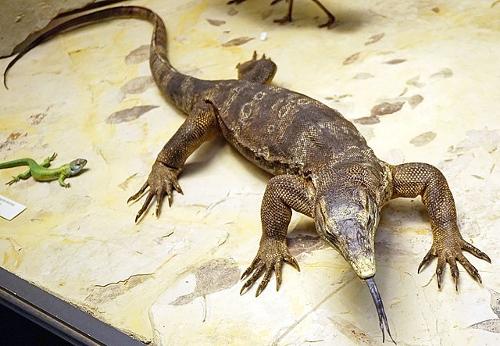 Asian or common water monitor lizzardPhoto: Tiia Monto CC 3.0 Unported no changes made
Asian or common water monitor lizzardPhoto: Tiia Monto CC 3.0 Unported no changes made
There are also many glider kites on Kalimantan and Sumatra, including flying dragon ("Draco"), flying frog, flying gecko and flying cat.
The mangrove forests are inhabited by, among others, crabs, mudhoppers, kingfishers and the bizarre-looking proboscis monkey, which only occurs on the island of Borneo.
Sulawesi is a special case. Most animals are of Asian origin; however, the two types of couscous (including bear couscous) that occur here are unmistakably marsupials and typically Australasian.
Animals that are found nowhere else are dwarf or chamois buffalo (anoa), the babirusa, a wild boar with curved tusks, the reticulated python, the great palm marten, the Sulawesi tarsier or 'tarsier' (with a length of 10 cm the smallest monkey in the world) and the crested macaque or black baboon.
The Togian Islands is home to the largest terrestrial arthropod, the coconut palm lobster or the flapper thief, related to the hermit crab. These huge lobsters, at least the males, can reach a weight of five kilos and their outstretched claws have a wingspan of a whopping three feet.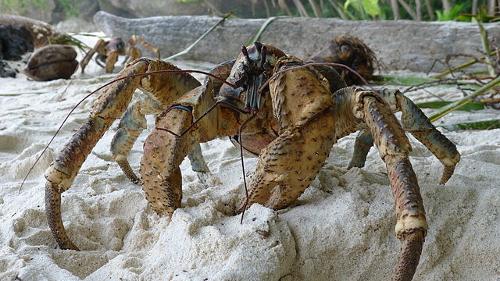 Coconut crab, robber crab or palmthief crab IndonesiaPhoto: John Tann from Sydney, Australia CC 2.0 Generic no changes made
Coconut crab, robber crab or palmthief crab IndonesiaPhoto: John Tann from Sydney, Australia CC 2.0 Generic no changes made
Another special feature is the maleo or hammerhead, a ratite species that buries its eggs in the sand - the eggs are incubated by the volcanic heat.
In Indonesia there are about 1500 bird species, including many Australasian species such as the cassowary (on Irian Jaya there are three species: the helmet cassowary, the orange-necked cassowary and the dwarf cassowary), cockatoos, many other parrot species and more than forty bird of paradise species. which only occur in the North Moluccas, the Aroe Islands and Irian Jaya. Of the bird world, the majestic argus pheasant, trogons, leaf birds, crown pigeons, barbet birds and long-legged grouses should also be mentioned. The peacock is only found in Java.
What is special is that of the 600 bird species identified on Borneo, 128 do not occur in Kalimantan.
The Moluccas are home to approximately 350 bird species, including the endemic Wallace bird of paradise and the large red-crested cockatoo.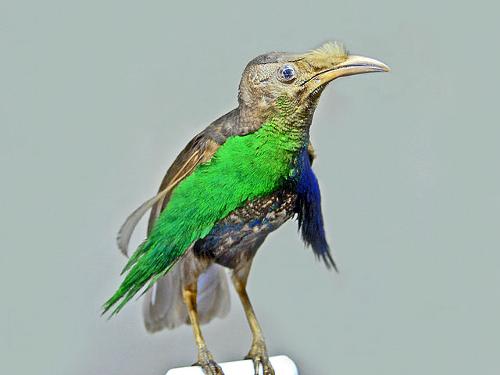 Standardwing bird-of-paradise also known as Wallace's standardwingPhoto: Hectonichus CC 3.0 Unported no changes made
Standardwing bird-of-paradise also known as Wallace's standardwingPhoto: Hectonichus CC 3.0 Unported no changes made
The rainforests of Sumatra and Kalimantan are home to exotic birds such as Schneider's pitta, bronze-tailed peacock-pheasant, kingfishers, ibises and nine species of hornbill. Sumatra has 465 bird species, 13 of which are endemic. After Irian Jaya, Sumatra is the richest bird.
In Bali, the bird species are especially interesting, including the very rare, beautiful "jalak putih" or white Bali starling, parrot amadines, rice birds, purple barots, jassanas and weaver birds.
Pulau Komodo is located in the middle of the strait between Sumbawa and Flores. Here comes the Komodo dragon or giant monitor, the largest monitor lizard in the world. Also on the islands of Padar, Rinca, Gili Motong and part of (mainland) West Flores. The Komodo dragon, called "ora" by locals, is one of the oldest living animal species, dating back to the Eocene 60 million years ago. Their current number is estimated at 5000 copies.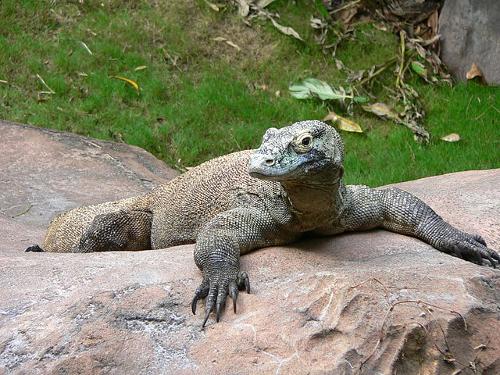 Komodo dragon IndonesiaPhoto: Raul654 CC 3.0 Unported no changes made
Komodo dragon IndonesiaPhoto: Raul654 CC 3.0 Unported no changes made
Adult males can reach a weight of 150 pounds and grow up to three meters in length. Females are a lot smaller and lay about thirty eggs at a time.
Crocodiles are limited to the coasts and some rivers. The freshwater crocodile ("buaya") of Irian Jaya can reach a length of seven meters. The green tree python is also found on Irian Jaya and the king cobra is the largest of the many poisonous snake species that live in the forests.
Geckos (Ind. Tokeh) and a smaller species, the "cicak", are everywhere and often live with people in the house.
The number of fish species is very large. The cyprinids, the labyrinth fish and the catfish, which mainly inhabit the freshwater, are absent on the eastern islands, which already have a poorer freshwater fauna. In the waters of Indonesia is the once rarest shell in the world, the Conus gloriamaris, nicknamed the "Glory of the Sea", which was for sale in a catalog for 120 guilders in the mid-eighteenth century, now about 2500 euros.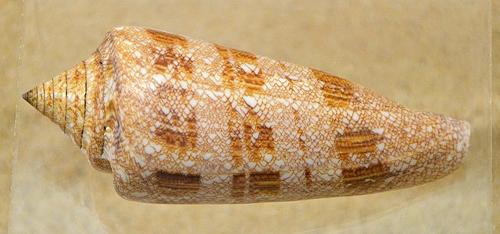 Conus gloriamaris, once the most expensive shell in the worldPhoto: Amada44 CC 3.0 Unported no changes made
Conus gloriamaris, once the most expensive shell in the worldPhoto: Amada44 CC 3.0 Unported no changes made
The coral reefs in the east of the archipelago are among the richest in the world; sea turtles are seriously threatened in their survival there. In the Citirem Nature Reserve, the green sea turtle lays its eggs on the beach in August-October. The Aru Archipelago of the Moluccas is an important nesting area for several species of sea turtles, including the protected leatherback and the Loggerhead tortoise. The Kai Islands are breeding grounds for the green turtle, loggerhead turtle and hawksbill turtle.
In some rivers on Kalimantan a striking animal swims: the "pesut" or Irrawaddi dolphin. This dolphin lives in the shallow and murky water of the Mahakam, among others, where there are relatively many fish.
Indonesia is extremely rich in insects and other invertebrates; the land leeches are well known. Some native insects are very large, such as the Atlas moth and some stick insects, which can grow up to 20 centimeters in length. Irian Jaya has thousands of butterfly species. The most spectacular are undoubtedly the birdwing butterflies, "kupu-kupu sayap burung". They can reach a wingspan of 33 cm.
The "Wallace Line"
The low sea level during the ice ages and the rise since then has had important consequences for the flora and fauna of the archipelago. The dryness of Sahul land during the Ice Age allowed plants and animals to move freely across the area west of the Kalimantan-Bali line during that period.
Only to the east of these islands were they stopped by a deep sea. That same sea also held back the flora and fauna from the eastern part of Indonesia, Sahul land and Australia. This old dividing line is still recognizable in the differences in flora and fauna between the two areas.
The Briton Alfred Russell Wallace (1823-1917), a contemporary of Darwin, was the first naturalist to discover that the animal world east of Bali was different from that in the rest of Indonesia. Alfred Russell Wallace, IndonesiaPhoto: https://wellcomecollection.org/works/zbg5wd4p CC-BY-4.0 no changes made
Alfred Russell Wallace, IndonesiaPhoto: https://wellcomecollection.org/works/zbg5wd4p CC-BY-4.0 no changes made
He drew an imaginary boundary, later called the "Wallace Line," which was based on the ancient coastline of the Asian continental shelf and marked the difference between the oriental and Australian fauna. To the west of the line (Sumatra, Kalimantan, Java, Madura and Bali) the animal world is oriental, to the east (Irian Jaya) Australian, while in the transition area (Sulawesi, Nusa Tenggara and the Moluccas) there is a mixture of these two types of fauna. In November 2010, biologists in the Indonesian jungle discovered a new monkey species with bullet eyes and large ears, the University of Frankfurt announced. It is a new species of the goblin lemurs that look a bit like stuffed animals and that were given the name Tarsius Wallacei, after the British naturalist Alfred Russel Wallace (1823-1913). The Goblin Lemurs are only four inches in size and are among the smallest monkeys in Asia.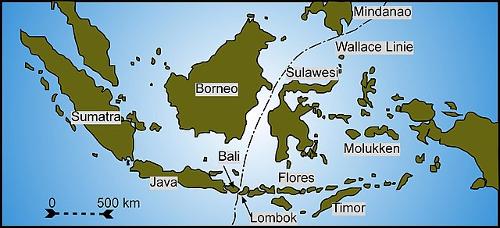 Wallace Line IndonesiaPhoto: Gunnar Ries CC 2.5 Generic no changes made
Wallace Line IndonesiaPhoto: Gunnar Ries CC 2.5 Generic no changes made
Sources
Dalton, B. / De Indonesië reisgids
Elmar
Darmawie-van Oijen, J. / Indonesië : handboek voor reizigers
Babylon-De Geus
Homburg, E. / Indonesië
Elmar,
Indonesië
Cambium
Lyle, G. / Indonesia
Chelsea House
Martyr, D. / Indonesië
Van Reemst
Mastenbroek, B. / Kijk op Indonesië
Elsevier
Muller, K. / Indonesië : het 13.000 eilandenrijk
Becht
Oosterman, I. / Indonesië
ANWB Media
Schulte Nordholt, N. / Indonesië : mensen, politiek, economie, cultuur
Koninklijk Instituut voor de Tropen / NOVIB
Te gast in Indonesië
Informatie Verre Reizen
Wassing, R. S. / Indonesië : Java, Bali, Lombok, Sumbawa, Komodo, Flores, Sumba, Timor, Sumatra, Zuid- en Oost-Kalimantan, Sulawesi, Singapore
Gottmer
Witjes, B. / Indonesië
Stichting Teleac
CIA - World Factbook
BBC - Country Profiles
Copyright: Team The World of Info